Secondary Treatment
Biological Process – Activated Sludge
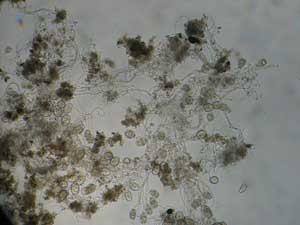
Organic Matter and Microorganisms
The activated sludge process occurs in the aeration tanks and the secondary clarifiers. For this process, a concentration of microorganisms is maintained in the wastewater. These microorganisms are commonly referred to as bugs. They are predominantly aerobic, meaning they need oxygen. The amount of oxygen consumed by the bugs is called biochemical oxygen demand, or BOD. The aerobic aeration tanks provide the dissolved oxygen needed to satisfy the BOD.
The bugs require a specific type of environment to survive and carry out the process. In order to maintain this environment, many things must be monitored: pH, temperature, dissolved oxygen, and available food or organic matter.
The primary functions of the bugs are the removal of organic material and ammonia. The bugs convert organic matter into other compounds such as carbon dioxide and water. The secondary role of the bugs is to assist in flocculation and settlement of the solids in the system.
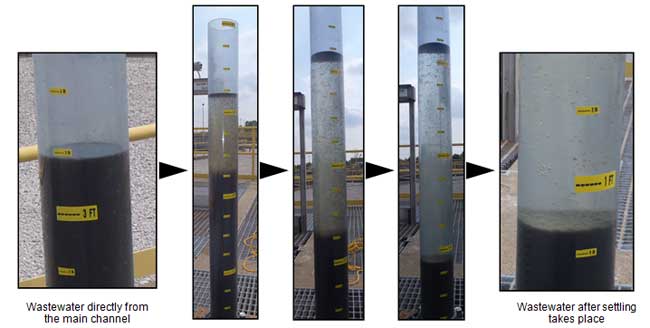
Sludge Settling
This allows the solids to be easily removed and recycled or wasted. In order to maintain a good concentration of bugs, much of the sludge removed from the secondary clarifiers is recycled. This sludge is referred to as return activated sludge (RAS). There are also times some of the sludge must be wasted. This sludge is called waste activated sludge (WAS). Some wasting is required in order to maintain a healthy concentration of bugs.
Types of Bugs:
- Bacteria – Bacteria break down organic matter. They can also aid in flocculation. \
- Nitrifying bacteria – Includes the two types: Nitrosomonas and Nitrobacter. The Nitrosomonas convert ammonia to nitrite, while the Nitrobacter converts the nitrite to nitrate.
- Protozoa – Protozoa eat bacteria, break down organic matter, and aid in flocculation. They are used as an indicator for the quantity and quality of bacteria because they can be seen under a regular microscope.
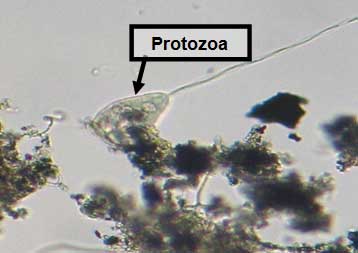
- Rotifers – Rotifers eat bacteria and particulate matter in the sludge. Rotifers also secrete a type of mucous that aids in flocculation. They are also used as an indicator for the quantity and quality of bacteria because they can be seen under a regular microscope.
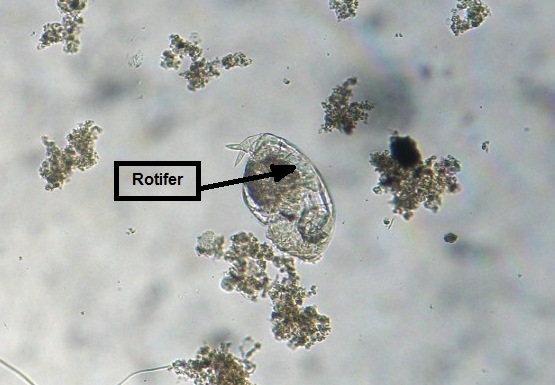
Biological Processes: Nitrification/Denitrification
Nitrification consists of two steps. During the first step of the process, bacteria called Nitrosomonas convert ammonia to nitrite. In the second step, bacteria called Nitrobacter convert the nitrite to nitrate. These bacteria, commonly known as nitrifiers, require dissolved oxygen in the water in order to perform the steps of the nitrification process.
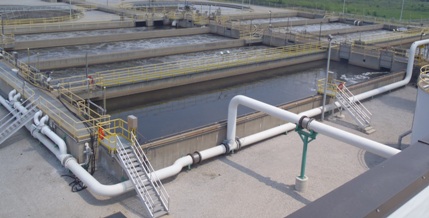
Aeration Tanks – Air flows through the white pipes to the aeration tanks to add oxygen and mix the water
The nitrification process also produces acid. The acid can cause the pH of the water to drop. If the pH drops too low, the growth rate of the nitrifiers will decrease. The optimum range for the nitrifiers is neutral to slightly basic.
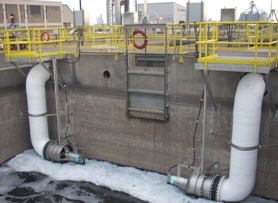
Nitrate Recycle Pumps
The denitrification process is an anaerobic process. This means that the process takes place in water with no dissolved oxygen available. At American Bottoms, this process occurs in the anoxic tanks located at the beginning of the aeration tanks. The denitrifying bacteria in the anoxic tank require oxygen. When no dissolved oxygen is available in the wastewater, these bacteria will use the oxygen from nitrogen compounds in the recycled flow of water coming from the end of the aeration tanks. The bacteria in the anoxic tank strip the oxygen from the nitrogen compounds. The remaining nitrogen gas bubbles to the top of the tank.
Denitrification produces alkalinity. This helps to balance the pH after the nitrification process has occurred. The alkalinity produced during the denitrification process causes the pH to rise. Similar to the nitrification process, the optimum pH level is neutral to slightly basic.
Aeration Tanks:
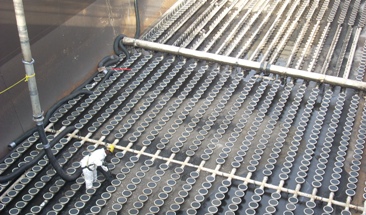
Diffusers line the bottoms of the aeration tanks
American Bottoms has two sets of 4 aeration tanks. The initial tank in each set is anoxic, meaning that it contains very little or no dissolved oxygen. The remaining three are aerobic and have a constant supply of dissolved oxygen provided by an oxygen feed system. The oxygen feed system consists of a turbo blower, piping to the aeration tanks, and diffusers lining the bottom of the aerobic aeration tanks. The system also has backup multistage centrifugal blowers.
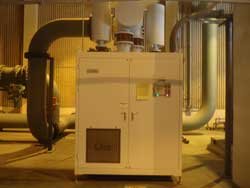
Turbo Blower
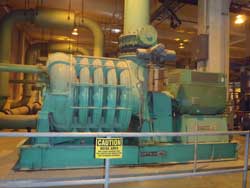
Centrifugal Blower
The wastewater travels in a serpentine pattern through the aeration tanks. This flow pattern keeps the wastewater in the tanks for a relatively long period of time. During this time, the wastewater receives constant mixing from the air being blown into the tanks. The long contact time and complete mixing help the microorganisms in the wastewater to come into contact and feed on the organic matter suspended in the wastewater.
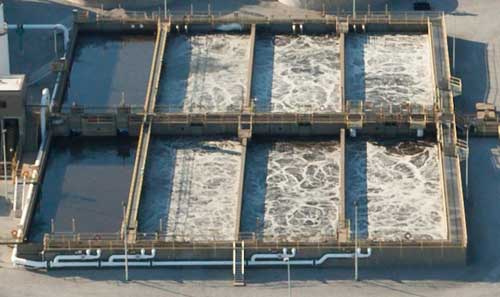
Secondary Clarifiers
American Bottoms has four 12 foot deep, 130 foot diameter secondary clarifiers. The secondary clarifiers are essential to the activated sludge process. Much of the sludge removed from these clarifiers is recycled to maintain the activated sludge process. The secondary clarifiers are also the final stage in the treatment process at American Bottoms before the water is reintroduced to the environment.
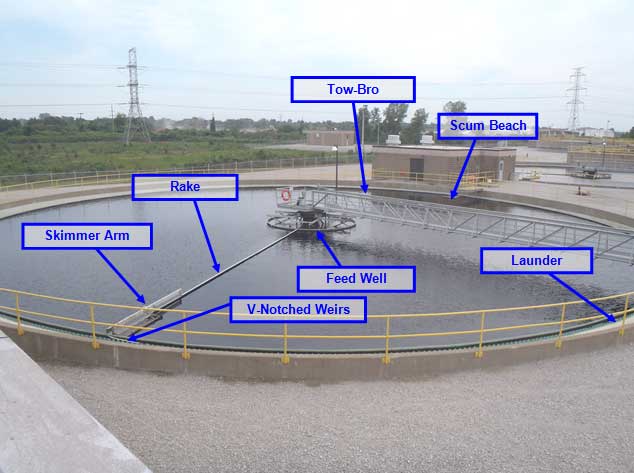
Secondary Clarifiers: Feed Well
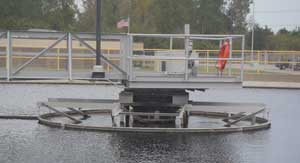 The feed well is located in the center of the clarifier. It is an 18 foot diameter circular well that spans about a quarter of the depth of the clarifier. The wastewater is pumped through a vertical pipe into the feed well. The speed of the incoming water is slowed, and the water evenly distributes around the tank.
The feed well is located in the center of the clarifier. It is an 18 foot diameter circular well that spans about a quarter of the depth of the clarifier. The wastewater is pumped through a vertical pipe into the feed well. The speed of the incoming water is slowed, and the water evenly distributes around the tank.
Secondary Clarifiers: Skimmer Arm & Scum Beach
The skimmer arm is used to remove the floating solids such as scum and grease from the secondary clarifier. The arm makes one complete revolution around the clarifier every 33 minutes. In order to allow the sludge to settle out, the water must be kept as calm as possible. As the skimmer arm travels around the clarifier, it pushes the scum in front of it. Once it reaches the scum beach, the arm traveling along the edge of the clarifier weighs down a lever that opens the door to the scum hopper. The scum is pushed over the scum beach and into the open hopper. The scum collected from the secondary clarifiers is sent on to the secondary thickeners.
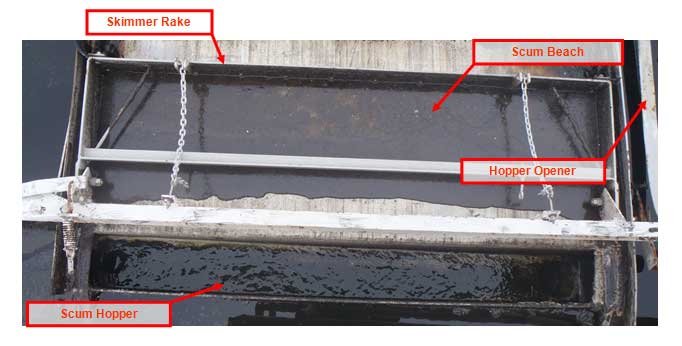
Rake
The rake at the bottom of the tank spans half the diameter of the clarifier. The tines are angled to push the settled sludge to the center of the tank where the waste activated sludge is removed. The rake rotates very slowly so the settled sludge is not disturbed.
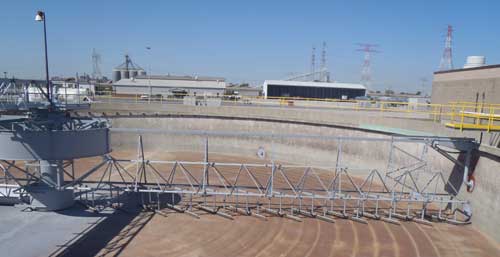
Tow-Bro
The Tow-Bro is opposite the rakes on the secondary clarifiers. It provides quick removal of the activated sludge settling to the bottom of the secondary clarifier. Quick removal of the sludge helps to maintain a clean effluent. The Tow-Bro is a hydraulic vacuum. Sludge is sucked from the bottom of the clarifier through the holes lining the tube. The sludge is either sent back to the aeration tanks as return activated sludge or wasted and sent through the sludge handling process.
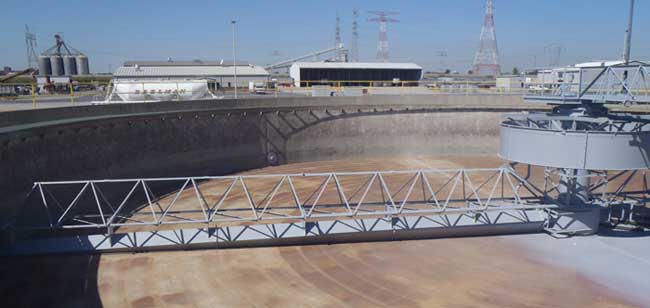
V-Notched Weirs & Launder
V-notched weirs line the outer edge of the clarifier. The weirs help to ensure that the water leaves the clarifier evenly which helps to keep the water calm. There is also a baffle located before the weirs. It prevents any of the floating solids from escaping over the weirs.
The wastewater flowing over the weirs flows into the launder. The launder is a slightly sloped channel that surrounds the clarifiers. The effluent water drains from the launder and flows into the main channel to leave the plant.
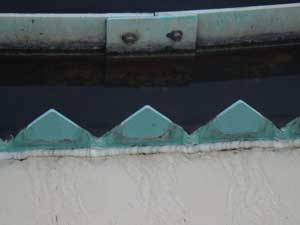
V-Notched Weirs
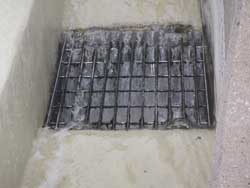
Launder Drain
Return Activated Sludge & Waste Activated Sludge
RAS system:
Return activated sludge, or RAS, is very important to the activated sludge process. The sludge settling to the bottom of the secondary clarifiers contains the microorganisms from the aeration tanks. These microorganisms are needed to clean the wastewater. By recycling the ones that have been removed from the clarifiers, the concentration of microorganisms can be maintained. The return activated sludge system consists of four dry pit pumps that pump the RAS back to the aeration tanks.
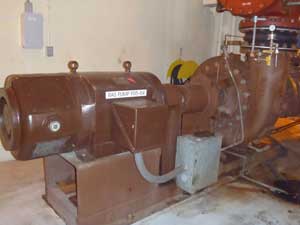
Return Activated Sludge Pump – Pumps RAS back to the aeration tanks
WAS system:
In order to maintain a healthy concentration of microorganisms, some of the activated sludge must be wasted. This sludge is known as waste activated sludge or WAS. Wasting a small percentage of the activated sludge ensures that the microorganisms stay a specific age and active. Wasting also prevents and overabundance of microorganisms. The food to microorganism rate can have a great effect on the effectiveness of the activated sludge process. The WAS system consists of four dry pit pumps that pump WAS to the thickeners to increase solids concentration prior to dewatering.
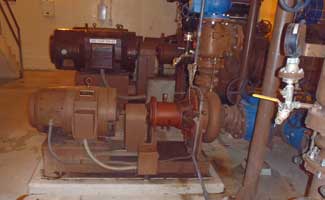
Waste Activated Sludge Pump – Pumps WAS to the thickeners
